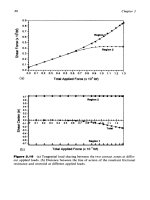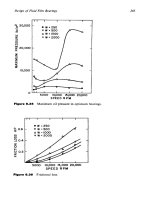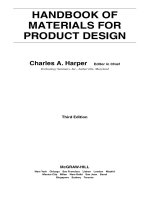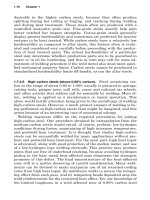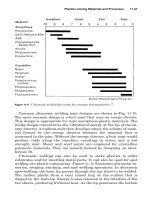product design development 1 pptx
Bạn đang xem bản rút gọn của tài liệu. Xem và tải ngay bản đầy đủ của tài liệu tại đây (321.79 KB, 28 trang )
1
Product Design & Development
and
New Products Management
2
• The following are based on the book
“Product Design and Development” by K.
T. Ulrich and S. D. Eppinger
3
Introduction
• Definition of Product and Product
Development (PD)
• Characteristics of a Successful Product
Development
• Who design and develops products
• Duration and Cost of Product
Development
• The Challenges of Product Development
4
Definition of a Product and Product
Development
• A Product is something sold by an
enterprise to its customers
• Product Development is the set of
activities beginning with the perception of
a market opportunity and ending in the
production, sale,and delivery of a product
5
Why Is Product Development
Important
• It is “big business”
• Hundred billion dollars
• New products answer to biggest problems
• A successful new product does more good
for an organization than enything else
• It is great life; it is fun and exciting
6
Who ‘owns’ the problem
• Marketing
• Design
• Manufacturing
7
Product Development Process
Is a Roadmap
8
Characteristics of Successful
Product Development
• Product quality
– How good is the product resulting from
development ?
– Does it satisfy customer needs ?
– Is it robust and reliable ?
– Product quality is reflected in market share ?
• Product cost
– What is the manufacturing cost ?
– It includes capital equipment and tooling ?
9
Characteristics of Successful
Product Development
• Development time
– How long did the PD effort take ?
• Development cost
– How much spent in PD effort ?
• Development capabilities
– Did the team/firm acquire any experience for
future projects ?
10
Who Designs and Develops
Products
• Marketing
•Design
• Manufacturing
11
Challenges
• Trade-offs
• Dynamics
• Details
• Time pressure
• Economics
• Creation
• Satisfaction of
societal and
individual needs
• Team diversity
• Team spirit
12
Products vs. development effort
13
Products vs. development effort
14
Structured Methodologies
Structured methodologies are valid for
three reasons:
• They make the decision-making process
explicit
• They provide “checklists” to ensure that
important issues are not forgotten
• They are readily documented in a
structured way
15
Approach
Assumes the core functions of a firm to be:
• Marketing
• Design
• Manufacturing
16
Organizational realities
• Lack of empowerment of the team
• Functional allegiances transcending
project goals
• Inadequate resources
• Lack of cross-functional representation on
the project team
17
Products that make companies
successful
18
New Products Management
• The following are based on the book by
Merle Crawford and Anthony Di Benedetto
19
Opportunity Identification and
Selection
20
Some Hot New Products
• Kawasaki Z1000 – a “naked” sport bike with a minimal plastic
body designed to show off the inner workings.
• Trivection ovens – GE’s Profile and Monogram ovens use a
combination of thermal, convection, and microwave technology.
• PalmOne Treo 6000 – A handheld PDA with phone,
speakerphone, camera, music player, and keyboard.
• Clorox Bleach Pen – A gel pen that lets you put bleach where you
want to, such as on mildew between shower tiles.
• Apple’s iTunes Music Store – Allows you to download hundreds of
thousands of songs from the Internet to save or play on an Apple
iPod.
• P&G’s Mr. Clean Magic Eraser – Melamine scouring pad with an
eraser-like function: it wears down with use.
• Toyota Prius – Hybrid car with futuristic styling and 55 MPG gas
mileage.
21
Products of the Future
• Intelligent refrigerators will track food inventories, and will either provide a
hard-copy shopping list or send an electronic list to a home-delivery
service.
• Intelligent wallpaper will transform a wall to a television, a computer screen,
works of art, etc.
• Robotic lawn mowers will tend the grass within any specified boundary.
• “Nanny-cams” hidden in teddy bears permit parents to watch their children
at daycare; camera-surveillance systems will keep an eye on latchkey kids
home alone.
• Holographic storage will be used to store and retrieve home videos.
• Lasers and decay-preventive gum and toothpastes will minimize the need
for the dentist’s drill.
• Robots will dispense gasoline, and know your preferred grade.
• “Smart” heart pacemakers will be placed in the wrist.
22
Not All New Products Are
Planned
• Microwave ovens
• Aspartame (NutraSweet)
• ScotchGard fabric protector
• Teflon
• Penicillin
• X-rays
• Dynamite
In each case, an accidental discovery but someone knew
they had something when they saw it!
23
What Is a New Product?
• New-to-the-world (really-new) products (10% of new products):
Inventions that create a whole new market. Ex.: Polaroid camera,
Sony Walkman, Palm Pilot, Rollerblade skates, P&G Febreze and
Dryel.
• New-to-the-firm products (20%): Products that take a firm into a
category new to it. Ex.: P&G brand shampoo or coffee, Hallmark gift
items, AT&T Universal credit card, Canon laser printer.
• Additions to existing product lines (26%): Line extensions and flankers
in current markets. Ex.: Tide Liquid, Bud Light, Apple’s iMac, HP
LaserJet 7P.
• Improvements and revisions to existing products (26%): Current
products made better. Ex.: P&G’s continuing improvements to Tide
detergent, Ivory soap.
• Repositionings (7%): Products that are retargeted for a new use or
application. Ex.: Arm & Hammer baking soda sold as a refrigerator
deodorant; aspirin repositioned as a safeguard against heart attacks.
• Cost reductions (11%): New products that provide the customer similar
performance but at a lower cost. May be more of a “new product” in
terms of design or production.
24
What About…
• New Services?
• New Business-to-Business Products?
• New International/Global Products?
25
What Is a Successful New
Product?
90
40
10
0
10
20
30
40
50
60
70
80
90
Sometimes Quoted
in Press
Research Reports Sometimes Claimed
Percent of Products that Fail
Although you may hear much higher percentages, careful
studies supported by research evidence suggest that about
40% of new products fail somewhat higher for consumer
products, somewhat lower for business-to-business products.



